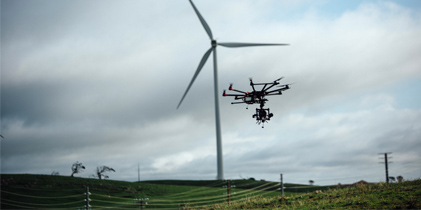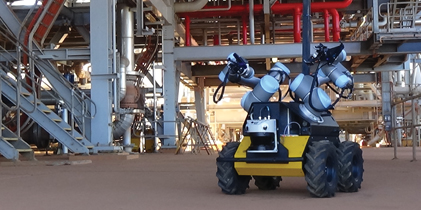
RESOURCES
Mineral, oil and energy resources are still vital to sustaining Australia’s ongoing economic prosperity, directly contributing more than 8 per cent of Australia’s GDP.
Australia’s resources sector
Resource operations produce 40% of Australia’s exports and are often located in remote and regional areas of Australia, which cover 85% of the Australian land mass (see also Agriculture, Chapter 10). However, the vast distances present numerous challenges in service delivery, freight distribution and telecommunications, many of which can be solved via the application of robotic technologies – a point acknowledged by the Minister for Resources and Northern Australia, Senator the Hon Matt Canavan. In his speech at the National Press Club 28 March 2018, he said that automation “fundamentally changes the geography of mining” [RE18]. As noted in Australia 2030: Prosperity through innovation (the Innovation and Science Australia 2030 plan, p18) [ISA17], Australia leads the world in mining automation technologies. This allows the Australian resources sector to operate safely and more efficiently in remote and harsh conditions (AT17).
Mineral, oil and energy resources are still vital to sustaining Australia’s ongoing economic prosperity, directly contributing more than 8 per cent of Australia’s GDP. The Resources sector dominates Australia’s export income, leading to massive investment in regional infrastructure, the development of an extensive industry support network and providing substantial direct and indirect employment, particularly in regional areas of Australia. In 2017, the resources sector employed more than 200,000 people and generated $AU205 billion in export revenue – 40 per cent of the nation’s export earnings. The sector has made significant improvements in health and safety over the past decade, reducing the incidence of both fatal and serious injuries. Worker fatalities have decreased 65 per cent from 12.4 worker fatalities per 100,000 workers in 2003, to 4.4 in 2015. However, the sector still has one of the highest fatality rates of any industry with an average of 9 workers dying each year. In addition to direct-mining activities, Australia’s Mining Equipment and Technology Services (METS) sector (the backbone of the resource supply chain) employs 386,000 people and delivers $AU90 billion to the Australian economy. However, over the past 20 years, half of Australia’s share of global exploration investment has moved offshore to countries where the technical risk of exploration is considered lower [AM17].
Australia’s METS sector is diverse and mainly comprised of SMEs (1-199 people) that provide specialised products and solutions for mineral exploration, extraction, and mining supply chains. This includes equipment manufacturers, engineering services, mine software products and other related equipment, services and technologies, where the primary function of the division, department, or specialty company is to support the mining and mineral extraction industries. METS companies derive most of their revenue from products and services supplied to the mining sector and, consequently, there is a mutually beneficial relationship between the METS and mining sectors. METS companies focus on developing solutions and providing services to mining companies, both domestically and globally. They are innovative and have a deserved reputation for developing cutting edge technologies. The partnership of both METS and mining companies with publicly funded research organisations (PFROs) has resulted in world-class outcomes, which have been deployed not only within the mining industry, but also in adjacent industries including the defence, automotive and manufacturing sectors.
Australia has abundant supplies of mineral resources, oil and gas, including the world’s largest reserves of lead, nickel, uranium and zinc. It is one of the top exporters of bauxite, alumina, iron ore, zinc, coal and the world’s largest exporter of liquid natural gas (LNG).
Australia is a secure source of rare earth elements (REE) and lithium, critical in the supply chain for modern transport and consumer goods. For example, REE are required for the magnets used in electric motors (modern cars), while lithium is required for use in batteries. Australia is the leading global supplier of mining related software and mining related consulting services. Australia also has considerable capacity in general mining services, mining construction (ECPM Services), after-market engineering services and contract mining services. Leading original equipment manufacturers (OEMs) such as Caterpillar, Komatsu and Atlas Copco (Epiroc) see Australia as the ideal testbed for advanced autonomous mining equipment.
Resource-based primary companies are likely to significantly embrace automation and robotics solutions over the next 15 years, which will have a positive effect on the overall productivity of the industry. The impact on the METS sector will directly relate to how well it adapts and develops automation and robotics capacity to meet this need, both on a local and international scale. However, greater automation may reduce jobs, or at least will change the types of jobs available. Over the five years to November 2020, employment in the mining industry is projected to decrease by 14.1 per cent nationally [DE16]. In his speech on 28 March 2018, Minister Canavan announced the establishment of a taskforce to lead development of a new resources statement, for release later in 2018 [RE18]. The work of the taskforce will encompass new ideas, new technologies, and policies to “attract investment, contribute to regional economic progress, build community support, simplify business, find new minerals, and ensure that Australia gets best use of its mineral resources before they are exported.” There is a clear role for robotics and automation in achieving all this, and the robotics industry welcomes the opportunity to engage with the taskforce by connecting contributors.

The nature and scale of activities in the resources sector sets it apart from other sectors.Australia’s mining innovation efforts to date have resulted...

The greatest ongoing impact for robotics in mining is between exploration and the mineral processing...

The resources sector has an important role to play in sharing knowledge of world-leading automation...


